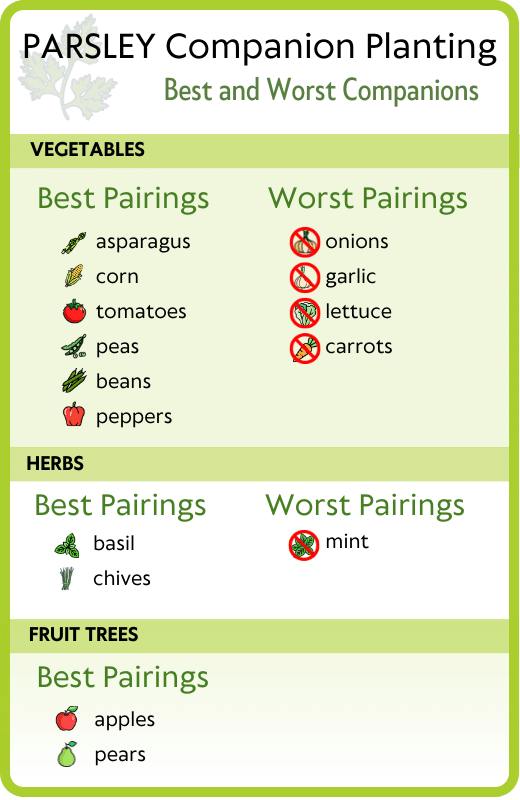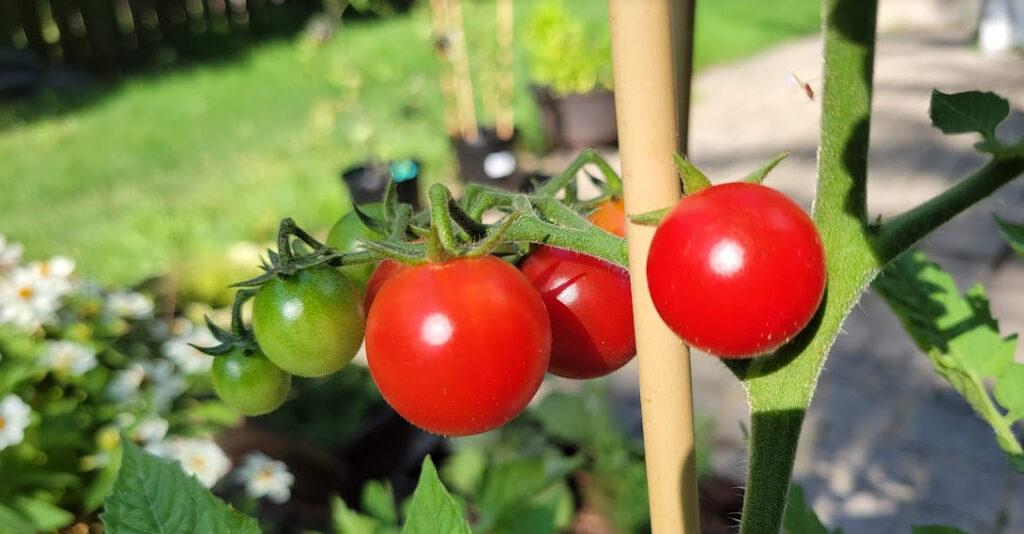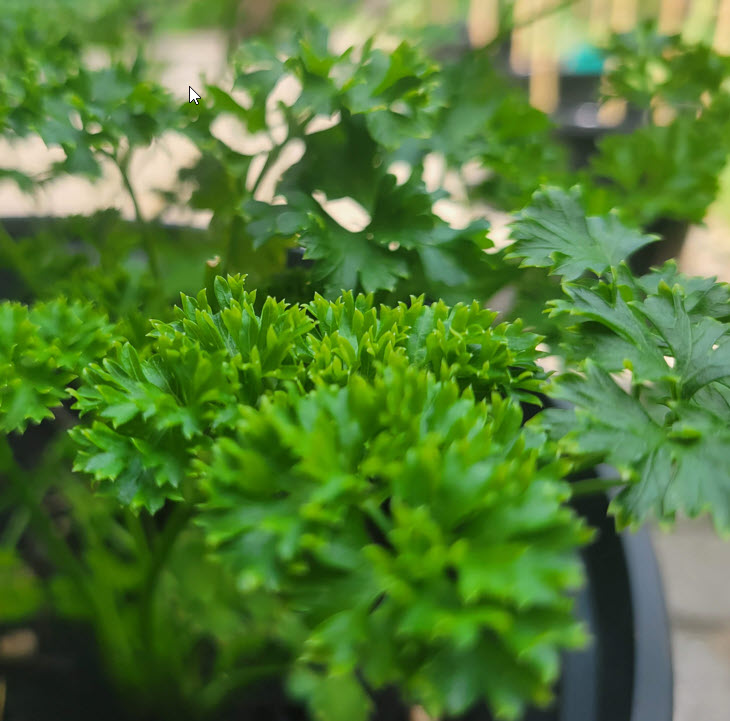This post may contain affiliate links which means I may receive a commission for purchases made through links. I only recommend products that I have personally used. As an Amazon Associate I earn from qualifying purchases. Learn more on my Private Policy page.

Companion planting with parsley offers a range of advantages for both novice and experienced gardeners alike. Not only does it enhance the health and growth of neighboring plants, but it also acts as a natural pest deterrent. So, what grows well with parsley?
Parsley grows well alongside asparagus, tomatoes, corn, beans, peppers, basil, and chives. Parsley companion planting provides advantages like repelling pests and supporting robust plant development.
Table of Contents
See my Comprehensive Guide to Parsley for a deeper dive into this vibrant herb.
Asparagus and Parsley

Parsley can greatly benefit the overall health of the asparagus bed. This powerful combination not only creates an attractive garden but also supports a thriving ecosystem.
Parsley Repels Common Pests from Asparagus
Parsley helps to repel pests like the notorious asparagus beetle, a destructive insect that can cause extensive harm to your asparagus plants.
Parsley emits strong aromas that act as a natural repellent for many pests, including the dreaded asparagus beetle. Parsley also has the ability to draw in helpful predatory insects such as parasitic wasps and braconid wasps. These insects consume harmful pests, helping to provide protection for your asparagus plants.
How to Manage Sunlight for Asparagus and Parsley
If you want to grow asparagus and parsley together, it’s important to consider their different sunlight preferences. Asparagus thrives in full sun and prefers a sunnier area that receives at least 6 to 8 hours of direct sunlight each day.
In contrast, parsley prefers partial shade or filtered sunlight. Find a spot nearby that offers some relief from the scorching midday sun or consider planting parsley in the shadow of taller plants or trellises. Consider moving potted parsley to a shadier spot during the hottest part of the day.

Corn and Parsley Companion Planting

A key benefit of parsley companion planting with corn is the natural pest control it provides. By planting parsley alongside your corn, you can attract parasitic wasps and tachinid flies. These beneficial insects are natural predators of worms, such as corn earworms, that often prey on corn This not only benefits your garden’s ecosystem but also ensures that you can enjoy healthier and pesticide-free produce.
Parsley Trap Crop Strategy
Another strategy for maximizing corn productivity is using parsley companion planting as a trap crop. A trap crop works by attracting pests away from the main crop towards itself, acting as a sacrificial plant.
In this case, parsley serves as an excellent trap crop for certain pests that target corn. The strong aroma of parsley lures pests away from your corn crop, helping to protect it from potential damage.

Tomatoes and Parsley: Perfect Garden Companions

Tomatoes and parsley not only complement each other in terms of taste, but they also have a mutually beneficial relationship when grown together.
Use Parsley to Attract Hoverflies to Combat Aphids
One of the key benefits of growing parsley alongside tomatoes is its ability to attract hoverflies. These tiny insects are natural predators of aphids, which can harm tomato plants by feeding on their leaves and stems.
Planting parsley near your tomato bed creates an inviting environment for hoverflies to visit and lay their eggs. Once hatched, the hoverfly larvae will consume aphids as their primary food source, helping control their garden population.

Peas and Beans as Parsley Companions

Planting parsley near crops of peas and beans offers several benefits, including the natural pest control provided by parsley, the nitrogen-fixing properties of peas and beans, and their shared growing requirements.
Nitrogen-Fixing Properties of Peas and Beans
Peas and beans are both known for their nitrogen-fixing properties. These plants have a symbiotic relationship with soil bacteria that convert atmospheric nitrogen into a form that plants can absorb. Growing peas or beans alongside your parsley provides an abundant supply of nitrogen to the soil, promoting lush foliage and vibrant green leaves.
Parsley for Natural Pest Control
Parsley attracts tachinid flies, which are natural predators of cutworms. Cutworms can wreak havoc on your vegetable garden, including beans and peas. Planting parsley near peas and beans can help to prevent cutworm infestations.
Shared Requirements of Peas, Beans, and Parsley
Peas and beans make excellent companions for parsley due to their shared soil, water, and humidity requirements. All three plants thrive in well-drained soil with a slightly acidic pH level (around 6-7). They also prefer consistent watering to keep the soil moist but not waterlogged.
Peppers and Parsley

While peppers are known for their ability to repel most pests, they can still fall victim to certain insects. Aphids and beetles can wreak havoc on your peppers, causing stunted growth and damage to leaves.
Parsley can help protect pepper plants by attracting beneficial insects like ladybugs and lacewings. These hungry predators feast on aphids and beetles, effectively keeping them at bay without the need for harmful pesticides.

Some natural pest control benefits achieved through this partnership include:
- Ladybugs: These adorable red-winged creatures are voracious eaters. Just one ladybug can devour hundreds of aphids in a single day.
- Lacewings: With delicate wings resembling lace, these insects are formidable predators of both aphids and beetle larvae.
- Hoverflies: Don’t be fooled by their bee-like appearance; hoverflies are excellent allies in the battle against aphids.
- Parasitic Wasps: These tiny wasps may sound intimidating, but they are gentle giants. They lay their eggs inside the aphids, effectively eliminating them from your pepper plants.
Ideal Herb Combinations for Parsley Companion Planting
Planting parsley with certain other herbs can enhance growth, deter pests, and create a harmonious herb haven.
Parsley and Basil: A Flavorful Duo

Parsley and basil share similar sunlight and water requirements and also both thrive when grown in consistently moist soil. Another advantage of basil companion planting with parsley is that parsley acts as a natural deterrent to pests like asparagus beetles and nematodes. By planting parsley alongside basil, you’ll provide protection for your basil plants against these unwanted invaders.

Chives and Parsley: A Dynamic Duo in the Garden

Chives and parsley are another fantastic pairing for companion planting. Parsley attracts pollinators and beneficial insects such as bees and ladybugs. These helpful creatures play a vital role in maintaining a healthy garden ecosystem by pollinating flowers and preying on harmful pests.
Both parsley and chives require sufficient sunlight for optimal growth, and they also both thrive in well-drained, fertile soil that is rich in organic matter.

Parsley Planting Near Apple and Pear Trees
Growing parsley near apple and pear trees may seem like an unconventional pairing, but it actually benefits both plants in numerous ways.
Pest Protection for Fruit Trees
Apple and pear trees are no strangers to troublesome pests like codling moths and gypsy moths, which can wreak havoc on the leaves, fruits, and overall vitality of these fruit-bearing trees. Parsley attracts braconid wasps that lay their eggs on the moth larvae in the vicinity, effectively reducing their population.
Bad Companion Plants for Parsley
Onions and Garlic: Avoiding Alliums

You need to be cautious about which plants you pair with parsley. One group of plants that should be avoided is alliums, such as onions, garlic, and shallots.
Planting parsley alongside alliums can result in stunted growth and reduced vitality for your parsley crop. They may also compete with parsley for nutrients and water in the soil. To ensure the best growth for your parsley, it’s best to keep it away from allium companions.
Lettuce: A Bolting Dilemma

While lettuce and parsley might seem like a natural pairing, planting them together can lead to some undesirable consequences. Parsley and lettuce have different growing requirements.
Lettuce may bolt or go to seed prematurely when planted too closely together. This premature bolting reduces the quality and yield of your lettuce crop, so giving each plant its own space in the garden bed is recommended.
Mint: An Invasive Neighbor

Mint is known for its aggressive spreading nature, making it an unsuitable companion for many plants, including parsley. Planting mint alongside parsley can cause problems due to its invasive tendencies.
Mint has a tendency to overtake other plants in the garden bed if not properly contained. It spreads through underground runners called rhizomes and quickly establishes itself as a dominant presence in the herb garden, which can crowd out parsley and other plants.
Carrots: Sibling Rivalry

Carrots and parsley belong to the same plant family, Apiaceae. While they may be related, they don’t always make the best companions in the garden. Both crops attract a common pest known as the carrot root fly, which can damage their roots and compromise their growth.
Carrots and parsley compete for nutrients in the soil. If planted too closely together, they may struggle to access enough resources for optimal growth.
It’s also worth noting that carrots and parsley have the potential to cross-pollinate if planted too closely together. This can lead to undesirable traits in future generations of saved seeds. To maintain pure varieties of both plants, ensure sufficient distance between them or grow them in separate areas of your garden.

Conclusion: Enhancing Your Garden with Parsley’s Companions
Incorporating parsley companion planting into your garden can greatly enhance the growth and health of your plants. By strategically selecting the right vegetables to plant with parsley, such as tomatoes, peppers, peas, beans, and corn, you can create a harmonious ecosystem that promotes mutual benefits and maximizes growth.
Herbs like basil and chives make excellent companions. They not only complement each other in terms of taste but also help repel pests naturally.
Parsley can even be used as a beneficial companion for apple and pear trees. Its ability to attract beneficial insects like hoverflies helps control harmful pests while promoting pollination.
To make the most out of parsley companion planting in your garden:
- Choose suitable vegetable companions based on their compatibility.
- Consider interplanting herbs for natural pest control.
- Experiment with different combinations to find what works best for your garden.
- Keep an eye out for any signs of pest infestation or nutrient deficiencies.
By following these guidelines and harnessing the power of parsley’s companionship, you can create a thriving garden that not only looks beautiful but also yields bountiful harvests.
Frequently Asked Questions (FAQs)
Can I plant parsley with other herbs?
Parsley can be planted alongside other herbs like basil and chives. They not only make great flavor combinations but also help repel pests naturally.
Does parsley companion planting work for fruit trees?
Parsley can be used as a beneficial companion for fruit trees like apple and pear. Its ability to attract beneficial insects helps control pests and promotes pollination.
Are there any plants that should not be planted with parsley?
While parsley is a great companion for many plants, it is best to avoid planting it near carrots, onions or lettuce. These plants may compete for nutrients or space, hindering their growth.
Can interplanting parsley with peas and beans improve their growth?
Interplanting parsley with peas and beans can improve soil fertility through nitrogen fixation. This leads to healthier plants and a bountiful harvest of legumes.
Last Updated on 25 October 2023 by Bob Lee

